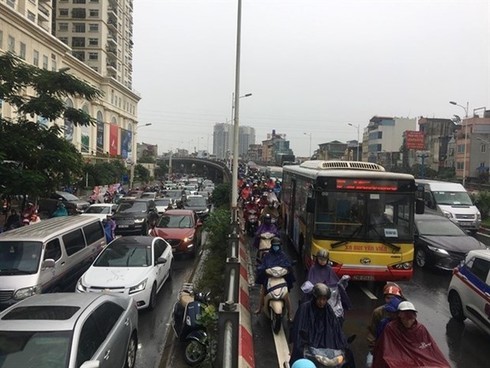Hanoi to conduct zoning to reduce traffic congestion
Mon, 28 Oct 2019 14:43:00 | Print | Email Share:
Hanoi is mulling two different options to restrict the use of motorbikes in the city before the 2030 ban.

The plan was discussed at a conference on October 25 hosted by the municipal Department of Transport on zoning to limit motorbikes and improve public transport.
Pham Anh Tuen, a representative of the Transport Development and Strategy Institute (TDSI) under the Ministry of Transport, said from 2011 to 2018, the number of motorbikes increased by 6.7 percent.
“With the same number of carried passengers, the street area occupied by motorbikes is 6.8 times higher than buses,” said Tuan.
The institute offered options to limit motorbikes on the capital's roads based on districts and traffic beltways.
In the first option, motorbikes will be restricted in 12 urban districts including Hoan Kiem, Hai Ba Trung, Ba Dinh and five rural districts of Gia Lam, Dong Anh, Hoai Duc, Thanh Tri and Dan Phuong from 2030.
Some 4.74 million people, 52 percent of the city’s population, are expected to be impacted.
The option has some shortcomings including difficulties in organising traffic flow, building parking lots and transit stations.
The second option based on beltways has been implemented in Singapore, London and China’s Guangzhou, according to TDSI.
Among five beltway roads of Hanoi that will be constructed by 2030, beltway road No.3 meets all standards to apply a motorbike ban.
“This is a closed belt with wide cross section eight to ten lanes. Some sections are urban highways which can divide traffic flow," said Tuan.
It is possible to build parking lots, transit stations and other supporting services near the road, he added.
TDSI recommended Hanoi ban motorbikes only when the public transport system can satisfy at least 60.5 percent of travel demand.
Some have proposed a motorbike restriction by hours on certain days and streets. Hanoi could also ban motorbikes by expanding pedestrian areas.
In other areas, motorbikes could only be restricted from 6am to 10pm and replaced by public transport.
“To achieve this goal, by 2030, Hanoi needs eight urban metro routes, 200 bus routes, 35,000 cabs, more than 50,000 contract cars, 20 mini bus routes and some 10,000 public bicycles,” said Tuan.
Vu Thi Vinh, former secretary of the Vietnam Association of Cities, cited China’s Guangzhou as an example of gradual motorbike banning to avoid disputes.
“In 16 years, city authorities raised awareness of people about the policy, restricted new motorbike registration, banned motorbikes on some streets, stopped out-of-town motorbikes from entering the city and eventually completely prohibited all motorbikes and destroyed old ones,” said Vinh.
Since Hanoi’s most severe traffic hotspot is in the western area, Vinh recommended first implementing the ban on Nguyen Trai, To Huu and Le Van Luong streets.
Vu Van Vien, Director of the Hanoi Department of Transport, highly appreciated these opinions.
“The public transport system needs improving to serve 80 percent of the city’s population by 2030 with a transit station 500m away from a residential area,” he said.
By: VNA/VOV
---------------------------------------------
Same category News :













